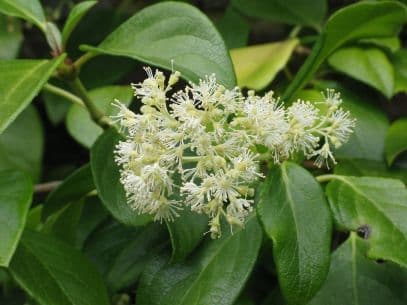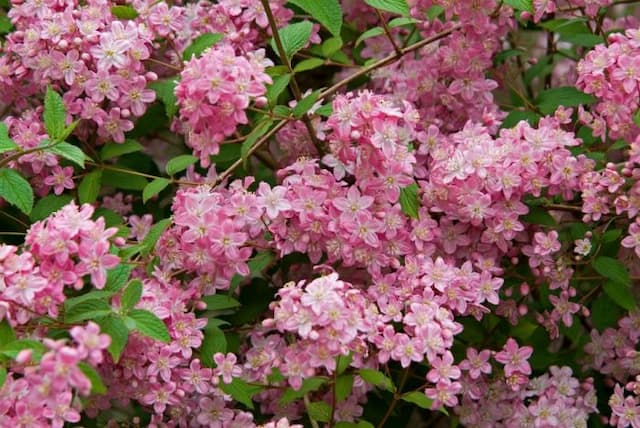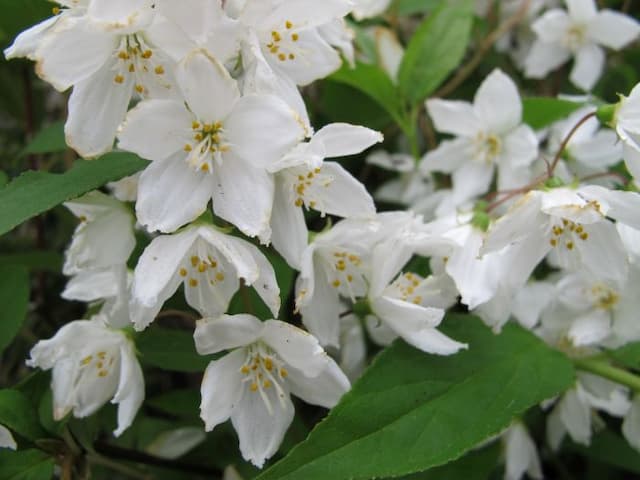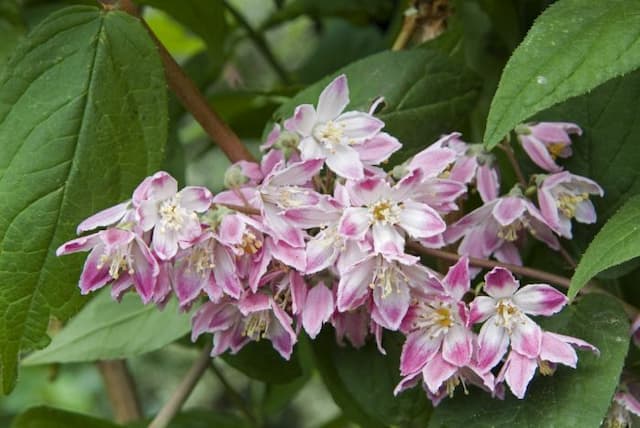Hydrangea [Hot Chocolate] Hydrangea aspera Hot Chocolate = 'Haopr012' (PBR)
![hydrangea [Hot Chocolate]](/_next/image?url=https%3A%2F%2Fplants-admin.emdemapps.com%2Fimages%2Fplants%2F%2Fimages%2F604b5a066e3bd.png&w=3840&q=75)
ABOUT
[Hot Chocolate] is a bushy, deciduous shrub, to 4m tall, with hairy leaves flushed a dark purple when young and with burgundy-red undersides. Flattened heads of flowers, comprising blue-purple inner fertile florets and cup-shaped soft pink ray florets, are borne from early summer to autumn
About this plant
 Names
NamesFamily
Hydrangeaceae
Synonyms
Hot Chocolate Hydrangea, Velvet Leaf Hydrangea
Common names
Hydrangea aspera 'Haopr012' Hot Chocolate (PBR).
 Characteristics
CharacteristicsLife cycle
Perennials
Foliage type
Deciduous
Color of leaves
Mixed
Flower color
Mixed
Height
6-10 feet (1.8-3 m)
Spread
6-10 feet (1.8-3 m)
Plant type
Shrub
Hardiness zones
7
Native area
Asia
Benefits
 General Benefits
General Benefits- Attractive Foliage - Hydrangea aspera Hot Chocolate features distinctive bronze-tinted leaves that add a unique color palette to garden settings.
- Decorative Blooms - The plant produces large, showy flower heads that can add visual interest to any landscape.
- Seasonal Interest - It offers seasonal beauty with flowers that bloom from summer to early autumn.
- Bee and Butterfly Attractant - The blooms of the Hydrangea aspera Hot Chocolate attract pollinators, supporting local ecosystems.
- Tolerates Partial Shade - It can thrive in partially shaded areas where other sun-loving plants might not perform as well.
- Adaptable to Soil Types - This hydrangea is known to be quite adaptable to different soil types, though it prefers well-drained, moist soils.
- Low Maintenance - Once established, it requires relatively low maintenance, which makes it suitable for various types of gardeners.
- Hardy Plant - It is relatively hardy and can withstand cooler temperatures, which is beneficial for gardens in temperate regions.
- Versatile Landscaping Uses - Can be used for mixed borders, woodland gardens, or as a specimen plant.
- Attracts Birds - Can provide shelter and occasionally attract birds, enhancing biodiversity in the garden.
 Medical Properties
Medical PropertiesThis plant is not used for medical purposes.
 Air-purifying Qualities
Air-purifying QualitiesThis plant is not specifically known for air purifying qualities.
 Other Uses
Other Uses- Photography and Art: The striking colour contrast of the dark foliage and light flowers of Hydrangea aspera Hot Chocolate make it a popular subject for photographers and botanical artists.
- Leaf Castings: Leaves of Hydrangea aspera Hot Chocolate can be used to make decorative leaf castings for garden ornaments or wall art due to their large size and textured surface.
- Dried Flower Arrangements: The blooms of Hydrangea aspera Hot Chocolate can be dried and used in floral arrangements for their long-lasting beauty and unique coloration.
- Educational Tool: Botany educators can utilize the plant to demonstrate plant anatomy, lifecycle, and pollination strategies due to its distinct flower structures.
- Privacy Screening: With its large size, Hydrangea aspera Hot Chocolate can be planted in rows to create a privacy screen in the garden while adding aesthetic appeal.
- Nature Crafts: Leaves and dried flowers of the plant can be incorporated into nature crafts like wreath making, especially in autumn for seasonal decor.
- Garden Design: Used in garden theming, Hot Chocolate can represent the 'chocolate' part of a food-themed garden due to its richly colored foliage and blooms.
- Wildlife Shelter: The dense growth habit of Hot Chocolate provides shelter and breeding spots for small wildlife, especially in a woodland garden setting.
- Plant Propagation Education: This cultivar can be used to teach budding horticulturists about propagation techniques, as it can be propagated by softwood cuttings.
- Horticultural Therapy: Gardening activities involving Hydrangea aspera Hot Chocolate, like pruning and caring, can be part of therapeutic horticulture programs, providing relaxation and satisfaction.
Interesting Facts
 Feng Shui
Feng ShuiThe Hydrangea is not used in Feng Shui practice.
 Zodiac Sign Compitability
Zodiac Sign CompitabilityThe Hydrangea is not used in astrology practice.
 Plant Symbolism
Plant Symbolism- Heartfelt Emotions: Hydrangeas often symbolize the expression of genuine emotions and profound feelings due to their lush and abundant flower heads.
- Gratitude: Giving hydrangeas as a gift can signify gratitude or thankfulness, often in a deeply personal and appreciative manner.
- Understanding: The multi-faceted blooms of hydrangeas can be a symbol of understanding and empathy, representing a comprehensive grasp of complex situations.
- Apology: In some contexts, hydrangeas bear the meaning of apology, or asking for forgiveness.
- Boastfulness: In the language of flowers, hydrangeas can sometimes denote vanity or boastfulness, reflecting the plant's showy and sometimes perceived as overly extravagant appearance.
 Water
WaterThe rough-leaved hydrangea should be watered deeply once a week, ensuring the soil is moist but not waterlogged. During hot or dry periods, watering frequency should increase to twice a week. Each watering session should provide the plant with approximately 1 to 1.5 gallons of water, allowing the moisture to penetrate deeply into the soil to encourage root growth. It's important to avoid overhead watering to prevent leaf and flower diseases. During the winter months, reduce watering since the plant will not require as much moisture.
 Light
LightThe rough-leaved hydrangea thrives best in partial shade with some morning sun or dappled sunlight throughout the day. An ideal spot would be an area that offers protection from the harsh afternoon sun, as too much direct sunlight can scorch the leaves and impact the plant's growth. Filtered sunlight beneath the canopy of open trees provides optimal lighting conditions for this hydrangea.
 Temperature
TemperatureRough-leaved hydrangeas prefer temperatures ranging between 60 and 75 degrees Fahrenheit. They can tolerate a minimum temperature of around 50 degrees Fahrenheit during the night and a maximum temperature of approximately 80 degrees Fahrenheit during the day. It is crucial to avoid exposing the plant to temperatures below 50 degrees Fahrenheit to prevent potential damage to the foliage and flowers.
 Pruning
PruningRough-leaved hydrangeas can be pruned in late winter or early spring before new growth begins to remove dead wood and encourage healthy new growth. Pruning should be done annually to maintain shape and to promote vigorous development. The best time for pruning is just after the plant has finished flowering; this also allows time for the plant to set buds for the next season.
 Cleaning
CleaningAs needed
 Soil
SoilRough-leaved Hydrangea thrives in rich, well-draining loam with organic matter; soil pH should be acidic to slightly alkaline (pH 5.5-7.5) for optimal growth.
 Repotting
RepottingRough-leaved Hydrangea typically requires repotting every 2-3 years to replenish soil and accommodate root growth.
 Humidity & Misting
Humidity & MistingRough-leaved Hydrangea prefers moderate to high humidity levels, but can adapt to regular household humidity.
 Suitable locations
Suitable locationsIndoor
Ensure bright indirect light and moist, well-draining soil.
Outdoor
Place in dappled shade with moist, fertile soil.
Hardiness zone
7-9 USDA.
 Life cycle
Life cycleHydrangea aspera 'Hot Chocolate' begins its life as a dormant seed which, when exposed to appropriate conditions of moisture and temperature, germinates and sprouts. The seedling, once emerged, grows into a young plant with characteristic velvety leaves, and as it matures, it develops a woody stem and a bushy structure. This hydrangea typically flowers in the summer, producing large, lacecap-style blooms with purple or blue florets surrounded by cream or pink bracts. After pollination, these flowers can produce small capsules of seed that, when mature, are dispersed to propagate the next generation. Throughout its life, the plant goes through cycles of growth in spring and summer, followed by a period of dormancy in autumn and winter where it loses leaves and conserves energy. With proper care and favorable conditions, Hydrangea aspera 'Hot Chocolate' can live for many years, entering a repeated cycle of growth, flowering, and dormancy.
 Propogation
PropogationPropogation time
Late Spring to Early Summer
The Hydrangea aspera 'Hot Chocolate', commonly known as the rough-leaved hydrangea, can be propagated by softwood cuttings during early summer. To propagate through this method, cuttings about 5 to 6 inches (12.7 to 15.2 cm) long are taken from new growth that is just beginning to harden, ensuring each cutting has several sets of leaves. The lower leaves are removed and a cut is made just below a leaf node. The base of the cutting is often dipped in rooting hormone to encourage root development. The cutting should then be planted in a mixture of peat and perlite, kept moist, and covered with a plastic bag or placed in a propagator to maintain a humid atmosphere. Roots typically form in 4 to 6 weeks, after which the new plants can be potted up individually.






![Rose deutzia [Yuki Cherry Blossom]](/_next/image?url=https%3A%2F%2Fplants-admin.emdemapps.com%2Fimages%2Fplants%2F%2Fimages%2F604b6510a383a.png&w=640&q=75)
![Hydrangea [Blackberry Pie]](/_next/image?url=https%3A%2F%2Fplants-admin.emdemapps.com%2Fimages%2Fplants%2F%2Fimages%2F604b56e2abc1d.png&w=640&q=75)

